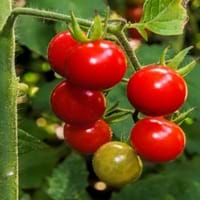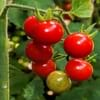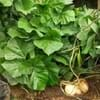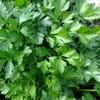Life Span
Annual
Annual and Perennial
Type
Vegetable
Bulb or Corm or Tuber
Origin
Mexico, Central America, South America
Central America, South America
Types
Red, Yellow and Baby Plum
Vine, Flowering plant
Number of Varieties
Not Available
Habitat
Cultivated Beds
All sorts of environments, Along Railroads, Banks, Moist Ditches, Roadsides, rocky banks of streams
USDA Hardiness Zone
11-15
10-13
Sunset Zone
A1, A2, A3, H1, H2, 1a, 1b, 2a, 2b, 3a, 3b, 4, 5, 6, 7, 8, 9, 10, 11, 12, 13, 14, 15, 16, 17, 18, 19, 20, 21, 22, 23, 24
21,22
Habit
Upright/Erect
Vining/Climbing
Minimum Width
Not Available
Flower Color
Yellow
Purple, Rose
Flower Color Modifier
Bicolor
Bicolor
Fruit Color
Red
Not Available
Leaf Color in Spring
Green, Dark Green
Purple, Dark Green, Black
Leaf Color in Summer
Green, Dark Green
Light Green
Leaf Color in Fall
Green, Dark Green
Several shades of Green
Leaf Color in Winter
Green, Dark Green
Light Green
Leaf Shape
Lanceolate
Acicular
Plant Season
Spring, Summer, Fall
Spring, Summer, Fall, Winter
Sunlight
Full Sun
Full Sun, Partial Sun
Growth Rate
Fast
Very Fast
Type of Soil
Loam, Sand
Clay, Loam, Sand
The pH of Soil
Neutral
Acidic, Neutral, Alkaline
Soil Drainage
Well drained
Well drained
Bloom Time
Indeterminate
Late Spring, Early Summer, Summer, Late Summer, Early Fall, Fall, Late Fall
Tolerances
Drought
Drought
Where to Plant?
Container, Ground, Pot
Container, Ground
How to Plant?
Seedlings
Cuttings, Leaf Cutting, Tuber propagation
Plant Maintenance
Medium
Medium
Watering Requirements
Requires regular watering
Keep the Soil well drained, Needs very little water
In Summer
Lots of watering
Lots of watering
In Spring
Moderate
Moderate
In Winter
Average Water
Average Water
Soil pH
Neutral
Acidic, Neutral, Alkaline
Soil Type
Loam, Sand
Clay, Loam, Sand
Soil Drainage Capacity
Well drained
Well drained
Sun Exposure
Full Sun
Full Sun, Partial Sun
Pruning
Dispose of diseased portions, Remove dead leaves
Remove damaged leaves, Remove dead branches, Remove dead leaves
Fertilizers
organic fertlizers
All-Purpose Liquid Fertilizer
Pests and Diseases
fungus
Red blotch
Plant Tolerance
Heat Tolerance
Drought
Flower Petal Number
Single
Single
Fragrant Bark/Stem
Yes
No
Foliage Texture
Medium
Coarse
Foliage Sheen
Matte
Matte
Attracts
Butterflies
Aphids, Beetles, Cutworms, Insects, Mites, Whiteflies
Allergy
Diarrhea, gastro-intestinal problems, Headache, Itchiness, Vomiting
Abdominal pain, allergic reaction, Nausea, Skin rash, Twitching of face
Aesthetic Uses
As decorated salad
Not Used For Aesthetic Purpose
Beauty Benefits
Acne, Glowing Skin, Maintains teeth healthy
Not Available
Environmental Uses
Air purification
Air purification
Medicinal Uses
Antioxidants, Metabolism
Cures constipation, Fiber, Low calories, lowering blood pressure, Potassium, ß-carotene, Vitamin A, Vitamin C
Part of Plant Used
Fruits
Leaves, Root, Shoots, Stem, Tuber
Other Uses
Cosmetics, Culinary use, For making oil, Repellent
Starch, Used As Food, Used as Ornamental plant
Used As Indoor Plant
Yes
Sometimes
Used As Outdoor Plant
Yes
Yes
Garden Design
Container, Edible, Herb, Vegetable, Houseplant
Container, Edible, Groundcover, Hanging Basket, Herb / Vegetable, Mixed Border, Rock Garden / Wall, Vine
Botanical Name
LYCOPERSICON esculentum 'Tiny Tim'
IPOMOEA batatas 'Blackie'
Common Name
Cherry Tomato
Blackie Sweet Potato Vine, Sweet Potato Vine
In Hindi
चेरी टमाटर
शकरकन्द
In German
Kirschtomate
Süßkartoffel
In French
Tomate cerise
Patate douce
In Spanish
Tomate cherry
Ipomoea batatas
In Greek
Ντοματάκι
Sweet potato
In Portuguese
Tomate cereja
Batata-doce
In Polish
Pomidor wiśniowy
Wilec ziemniaczany
In Latin
Cherry LycopersiciSusceptibility
Ipomoea batatas
Phylum
Magnoliophyta
Tracheophyta
Class
Magnoliopsida
Magnoliopsida
Order
Solanales
Solanales
Family
Solanaceae
Convolvulaceae
Clade
Angiosperms, Asterids, Eudicots
Angiosperms, Asterids, Eudicots
Tribe
Solaneae
Not Available
Subfamily
Solanoideae
Not Available
Number of Species
Not Available
Not Available
Season and Care of Cherry Tomato and Sweet Potato Vine
Season and care of Cherry Tomato and Sweet Potato Vine is important to know. While considering everything about Cherry Tomato and Sweet Potato Vine Care, growing season is an essential factor. Cherry Tomato season is Spring, Summer and Fall and Sweet Potato Vine season is Spring, Summer and Fall. The type of soil for Cherry Tomato is Loam, Sand and for Sweet Potato Vine is Clay, Loam, Sand while the PH of soil for Cherry Tomato is Neutral and for Sweet Potato Vine is Acidic, Neutral, Alkaline.
Cherry Tomato and Sweet Potato Vine Physical Information
Cherry Tomato and Sweet Potato Vine physical information is very important for comparison. Cherry Tomato height is 3,050.00 cm and width 30.50 cm whereas Sweet Potato Vine height is 15.00 cm and width Not Available. The color specification of Cherry Tomato and Sweet Potato Vine are as follows:
Cherry Tomato flower color: Yellow
Cherry Tomato leaf color: Green and Dark Green
Sweet Potato Vine flower color: Purple and Rose
- Sweet Potato Vine leaf color: Purple, Dark Green and Black
Care of Cherry Tomato and Sweet Potato Vine
Care of Cherry Tomato and Sweet Potato Vine include pruning, fertilizers, watering etc. Cherry Tomato pruning is done Dispose of diseased portions and Remove dead leaves and Sweet Potato Vine pruning is done Remove damaged leaves, Remove dead branches and Remove dead leaves. In summer Cherry Tomato needs Lots of watering and in winter, it needs Average Water. Whereas, in summer Sweet Potato Vine needs Lots of watering and in winter, it needs Average Water.





